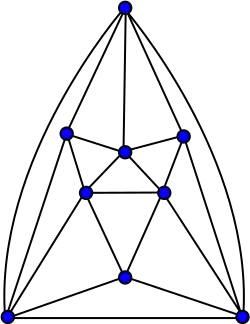Fritsch graph
In the mathematical field of graph theory, the Fritsch graph is a planar graph with 9 vertices and 21 edges. It was obtained by Fritsch[1] as a minimal sized counterexample to the Alfred Kempe's attempt to prove the four-color theorem.
| Fritsch graph | |
|---|---|
 The Fritsch graph | |
| Vertices | 9 |
| Edges | 21 |
| Radius | 2 |
| Diameter | 2 |
| Girth | 3 |
| Automorphisms | 12 |
| Chromatic number | 4 |
| Chromatic index | 6 |
| Properties | planar |
| Table of graphs and parameters | |
References
- Fritsch, Rudolf; Fritsch, Gerda (1998). The Four-Color Theorem. New York: Springer-Verlag. doi:10.1007/978-1-4612-1720-6.
This article is issued from Wikipedia. The text is licensed under Creative Commons - Attribution - Sharealike. Additional terms may apply for the media files.